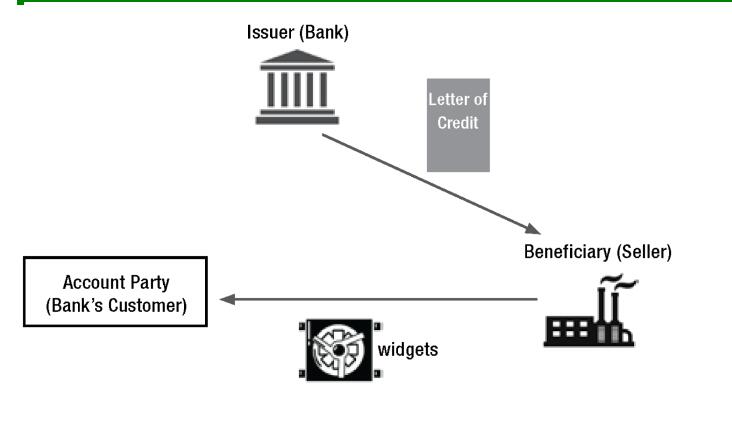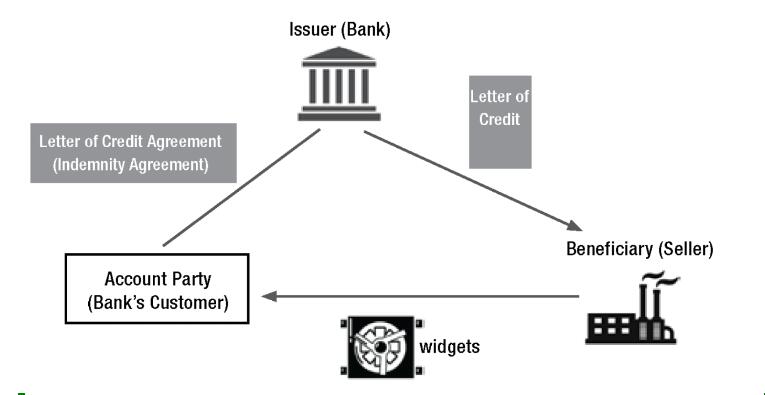Chapter 8 Letters of Credit
| Jurisdiction | United States |
Aletter of credit is a formal legal document used by a bank customer to provide assurance of prompt payment of an obligation. Payment is assured to the recipient from a credit-worthy payment source (a bank) and offers a straightforward means of immediate collection. There are many types of letters of credit and ways to use them. Letter of credit uses that frequently appear in bankruptcy cases include letters of credit used to purchase goods and services, letters of credit given as lease security deposits, letters of credit supporting surety bond facilities, letters of credit supporting insurance obligations and letters of credit issued as a part of larger credit facilities.
A. Letter of Credit Basics
A letter of credit is a three-party arrangement. A bank customer (the "account party") requests that the bank (the "issuer") issue a letter of credit naming a third-party recipient (the "beneficiary") as the beneficiary. The beneficiary presents the issuer with a written statement (sometimes called a "draft") and potentially other papers required by the terms of the letter of credit, which the issuer reviews. If the draft strictly complies with the requirements of the letter of credit, the issuer makes a payment (a "draw") to the beneficiary. The issuer's administration of the letter of credit is purely ministerial: The issuer is not concerned about any disputes that may exist between the account party and the beneficiary. If the beneficiary has strictly complied with the conditions of the letter of credit, the beneficiary receives payment.92 The issuer charges the account party a fee for the letter of credit and receives reimbursement of the draw from the account party.
An illustration of a letter of credit arrangement for a sale of widgets follows:

In this example, the beneficiary (the seller of the widgets) does not want to take the credit risk that the account party (the seller's customer), who is overseas, will not pay for the widgets, and the seller only wants to be able to collect in the U.S. The issuer (the bank) issues a letter of credit on behalf of its customer, the buyer of widgets (the account party), for the benefit of the seller (the beneficiary). The goods are shipped upon the seller's receipt of the letter of credit, which requires a signed delivery receipt from the buyer along with a draft for payment. Upon delivery of the goods, the seller gets the signed delivery receipt and draws on the letter of credit by presenting the receipt and a draft on the issuing bank. Assuming that the papers strictly conform to the requirements of the letter of credit, the issuing bank pays the seller. In this situation, the letter of credit itself may be the vehicle used to pay the seller, in which case it is referred to as a "merchandise" letter of credit.
B. Letter of Credit Documentation

A letter of credit document itself is a short, standard form that identifies the account party and the beneficiary, states the amount and the letter of credit's expiration date (sometimes called the...
To continue reading
Request your trial- American Bankruptcy Institute
- Navigating Banking in Bankruptcy: A Guidebook
- Front Matter
- About the Authors
- About the Editors
- Foreword
- Acknowledgments
- Table of Contents
- Chapter 1 Bankruptcy and Banking Basics
- Chapter 2 Understanding the Debtor's Treasury-Management System
- Chapter 3 Accounts
- Chapter 4 Automated Clearing House (ACH) Transactions
- Chapter 5 Automatic Payment Services
- Chapter 6 Checks
- Chapter 7 Credit Cards
- Chapter 8 Letters of Credit
- Chapter 9 Swap Agreements
- Chapter 10 Sweeps
- Chapter 11 Protection of Interests in Cash
- Chapter 12 Cash-Collateral and DIP-Financing Orders from the Perspective of the Deposit Bank
- Chapter 13 Cash-Management Orders
- Chapter 14 Customer-Identity Regulations and Their Effects on Banking Transactions in Bankruptcy
- Chapter 15 Customer Privacy in Bankruptcy
- Chapter 16 Compliance with § 345 of the Bankruptcy Code
- Chapter 17 Garnishments of Bank Accounts
- Chapter 18 Preferential- and Fraudulent-Transfer Issues
- Chapter 19 Debtor Pre-Filing Checklist: Bank Issues
- Chapter 20 Bank Checklist: Distressed Customers
- Glossary of Bank Products and Common Bank Terms
Subscribers can access the reported version of this case.
You can sign up for a trial and make the most of our service including these benefits.
Why Sign-up to vLex?
-
Over 100 Countries
Search over 120 million documents from over 100 countries including primary and secondary collections of legislation, case law, regulations, practical law, news, forms and contracts, books, journals, and more.
-
Thousands of Data Sources
Updated daily, vLex brings together legal information from over 750 publishing partners, providing access to over 2,500 legal and news sources from the world’s leading publishers.
-
Find What You Need, Quickly
Advanced A.I. technology developed exclusively by vLex editorially enriches legal information to make it accessible, with instant translation into 14 languages for enhanced discoverability and comparative research.
-
Over 2 million registered users
Founded over 20 years ago, vLex provides a first-class and comprehensive service for lawyers, law firms, government departments, and law schools around the world.
Subscribers are able to see a list of all the cited cases and legislation of a document.
You can sign up for a trial and make the most of our service including these benefits.
Why Sign-up to vLex?
-
Over 100 Countries
Search over 120 million documents from over 100 countries including primary and secondary collections of legislation, case law, regulations, practical law, news, forms and contracts, books, journals, and more.
-
Thousands of Data Sources
Updated daily, vLex brings together legal information from over 750 publishing partners, providing access to over 2,500 legal and news sources from the world’s leading publishers.
-
Find What You Need, Quickly
Advanced A.I. technology developed exclusively by vLex editorially enriches legal information to make it accessible, with instant translation into 14 languages for enhanced discoverability and comparative research.
-
Over 2 million registered users
Founded over 20 years ago, vLex provides a first-class and comprehensive service for lawyers, law firms, government departments, and law schools around the world.
Subscribers are able to see a list of all the documents that have cited the case.
You can sign up for a trial and make the most of our service including these benefits.
Why Sign-up to vLex?
-
Over 100 Countries
Search over 120 million documents from over 100 countries including primary and secondary collections of legislation, case law, regulations, practical law, news, forms and contracts, books, journals, and more.
-
Thousands of Data Sources
Updated daily, vLex brings together legal information from over 750 publishing partners, providing access to over 2,500 legal and news sources from the world’s leading publishers.
-
Find What You Need, Quickly
Advanced A.I. technology developed exclusively by vLex editorially enriches legal information to make it accessible, with instant translation into 14 languages for enhanced discoverability and comparative research.
-
Over 2 million registered users
Founded over 20 years ago, vLex provides a first-class and comprehensive service for lawyers, law firms, government departments, and law schools around the world.
Subscribers are able to see the revised versions of legislation with amendments.
You can sign up for a trial and make the most of our service including these benefits.
Why Sign-up to vLex?
-
Over 100 Countries
Search over 120 million documents from over 100 countries including primary and secondary collections of legislation, case law, regulations, practical law, news, forms and contracts, books, journals, and more.
-
Thousands of Data Sources
Updated daily, vLex brings together legal information from over 750 publishing partners, providing access to over 2,500 legal and news sources from the world’s leading publishers.
-
Find What You Need, Quickly
Advanced A.I. technology developed exclusively by vLex editorially enriches legal information to make it accessible, with instant translation into 14 languages for enhanced discoverability and comparative research.
-
Over 2 million registered users
Founded over 20 years ago, vLex provides a first-class and comprehensive service for lawyers, law firms, government departments, and law schools around the world.
Subscribers are able to see any amendments made to the case.
You can sign up for a trial and make the most of our service including these benefits.
Why Sign-up to vLex?
-
Over 100 Countries
Search over 120 million documents from over 100 countries including primary and secondary collections of legislation, case law, regulations, practical law, news, forms and contracts, books, journals, and more.
-
Thousands of Data Sources
Updated daily, vLex brings together legal information from over 750 publishing partners, providing access to over 2,500 legal and news sources from the world’s leading publishers.
-
Find What You Need, Quickly
Advanced A.I. technology developed exclusively by vLex editorially enriches legal information to make it accessible, with instant translation into 14 languages for enhanced discoverability and comparative research.
-
Over 2 million registered users
Founded over 20 years ago, vLex provides a first-class and comprehensive service for lawyers, law firms, government departments, and law schools around the world.
Subscribers are able to see a visualisation of a case and its relationships to other cases. An alternative to lists of cases, the Precedent Map makes it easier to establish which ones may be of most relevance to your research and prioritise further reading. You also get a useful overview of how the case was received.

Why Sign-up to vLex?
-
Over 100 Countries
Search over 120 million documents from over 100 countries including primary and secondary collections of legislation, case law, regulations, practical law, news, forms and contracts, books, journals, and more.
-
Thousands of Data Sources
Updated daily, vLex brings together legal information from over 750 publishing partners, providing access to over 2,500 legal and news sources from the world’s leading publishers.
-
Find What You Need, Quickly
Advanced A.I. technology developed exclusively by vLex editorially enriches legal information to make it accessible, with instant translation into 14 languages for enhanced discoverability and comparative research.
-
Over 2 million registered users
Founded over 20 years ago, vLex provides a first-class and comprehensive service for lawyers, law firms, government departments, and law schools around the world.
Subscribers are able to see the list of results connected to your document through the topics and citations Vincent found.
You can sign up for a trial and make the most of our service including these benefits.
Why Sign-up to vLex?
-
Over 100 Countries
Search over 120 million documents from over 100 countries including primary and secondary collections of legislation, case law, regulations, practical law, news, forms and contracts, books, journals, and more.
-
Thousands of Data Sources
Updated daily, vLex brings together legal information from over 750 publishing partners, providing access to over 2,500 legal and news sources from the world’s leading publishers.
-
Find What You Need, Quickly
Advanced A.I. technology developed exclusively by vLex editorially enriches legal information to make it accessible, with instant translation into 14 languages for enhanced discoverability and comparative research.
-
Over 2 million registered users
Founded over 20 years ago, vLex provides a first-class and comprehensive service for lawyers, law firms, government departments, and law schools around the world.
